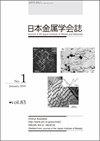700℃时Fe-Ni-Cr合金在空气和蒸汽中的氧化行为
IF 0.4
4区 材料科学
Q4 METALLURGY & METALLURGICAL ENGINEERING
引用次数: 0
摘要
研究了不同Ni含量的Fe︲Ni︲Cr合金在700℃空气和蒸汽中的高温︲氧化行为。蒸汽中的氧化质量增益高于空气中的氧化质量增益。在两种气氛下,氧化质量增益均随Ni含量的增加而减小。而空气中氧化质量增益与Ni浓度的关系较为复杂,当Ni含量达到35%时,氧化质量增益随Ni含量的增加而增加,随着Ni含量的增加而降低。但二元Ni︲20Cr的氧化质量增益明显增加。当合金在蒸汽中氧化时,没有观察到这种复杂的氧化行为。空气中局部形成内氧化带,未发生内氧化的区域形成铬氧化垢。内部氧化区形成的区域大小随Ni含量的变化而变化。在蒸汽中,合金的大部分表面积被内部氧化区所覆盖。20%的Cr含量被认为是不够的,但接近空气中唯一形成二氧化铬结垢的临界Cr含量。由于高Ni含量合金的氧渗透性较低,以及Cr向外扩散的交叉︲项效应,发现合金Ni含量决定了形成纯cr2o3结垢的临界Cr含量。[doi:10]2320 / jinstmet。[b201705])本文章由计算机程序翻译,如有差异,请以英文原文为准。
Oxidation Behavior of Fe-Ni-Cr Alloys at 700°C in Air and Steam
High ︲ temperature oxidation behavior of Fe ︲ Ni ︲ Cr alloys with different Ni contents in air and steam at 700 ℃ was investigated. Oxidation mass gain in steam was higher than that in air. In both atmospheres oxidation mass gain tended to decrease with increas ing Ni content. However, the Ni concentration dependence of oxidation mass gain in air was complex, i.e., oxidation mass gain increased with increase in Ni content up to 35 % then decreased with higher Ni content. But oxidation mass gain of binary Ni ︲ 20Cr significantly increased. Such a complex oxidation behavior was not observed when alloys were oxidized in steam. The internal oxidation zone was locally formed in air, and a Cr 2 O 3 scale was found to develop on the areas without internal oxidation. The size of area, where an internal oxidation zone was developed, changed depending on Ni content. In steam, most of the surface area of alloys was covered by an internal oxidation zone. Cr content, 20 % , was considered to be insufficient but close to the critical Cr content for exclusive Cr 2 O 3 scale formation in air. The critical Cr content for exclusive Cr 2 O 3 scale formation was found to depend on alloy Ni content due to lower oxygen permeability in alloys with higher Ni content and the cross ︲ term effect for Cr outward diffu -sion. [ doi:10 . 2320 / jinstmet.JB201705 ] )
求助全文
通过发布文献求助,成功后即可免费获取论文全文。
去求助
来源期刊

Journal of The Japan Institute of Metals
工程技术-冶金工程
CiteScore
0.70
自引率
0.00%
发文量
27
审稿时长
6-12 weeks
期刊介绍:
Information not localized
 求助内容:
求助内容: 应助结果提醒方式:
应助结果提醒方式:


